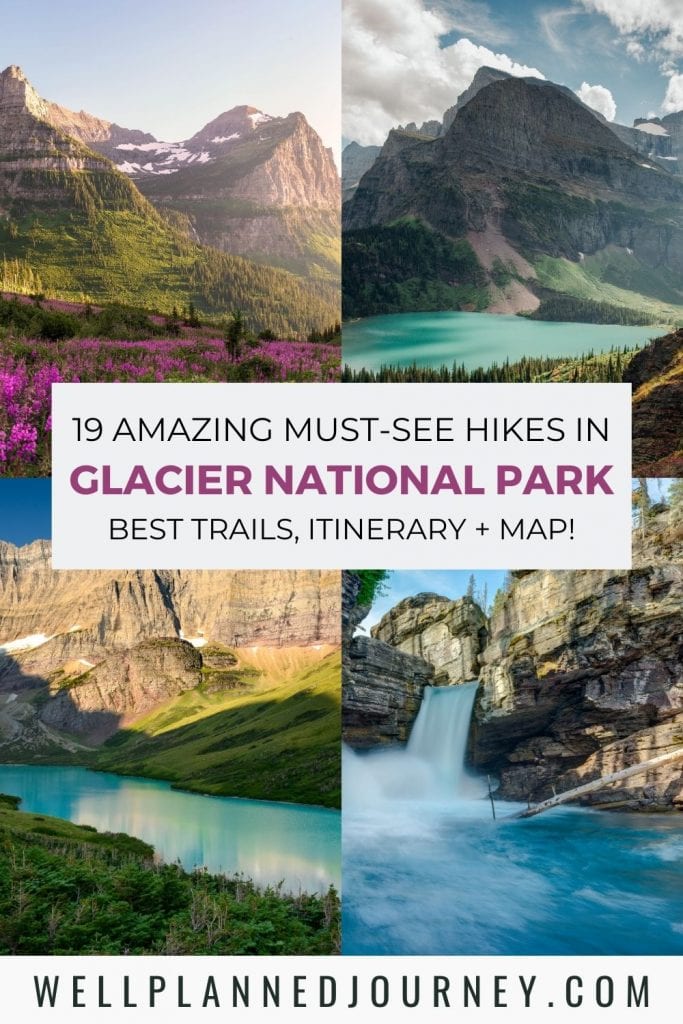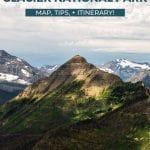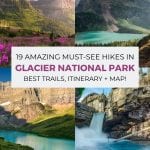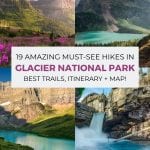Glacier National Park has over 700 miles of trails and over 50 day hikes, more than most other national parks. But, with only a few days in this incredible national park, how do you pick which hikes to do?
This guide is here to help, covering the 20 best hikes in Glacier National Park for 2024. You’ll discover all the can’t-miss sights and essential trails, from icy glaciers to stunning wildlife.
This guide covers the best hikes in West Glacier, Lake McDonald, Logan Pass, St. Mary, Many Glacier, and Two Medicine.
So keep reading for more information on the best time to hike in Glacier National Park, essential hiking tips, and where to stay near the trailheads!
Important Note
Glacier National Park requires all visitors to have a reservation to enter Going-to-the-Sun Road, North Fork, and Many Glacier starting May 24 until September 8, 2024. Read more about the Glacier National Park reservation system.
This post may contain affiliate links, where I may receive a small commission at no additional cost to you. Read more in this disclosure policy.
Glacier National Park At-A-Glance
Before diving in, here are a few highlights to help you plan your trip:
- Best Time to Visit: Summer is the best (and most popular) time to visit, thanks to the warm weather and all park facilities being open. Visit in early to mid-September to avoid peak crowds.
- Where to Stay: If you’re looking to stay in the park, I highly recommend the Many Glacier Hotel. To stay outside the park, look for accommodations in Babb or St. Mary, like St. Mary Village.
- How to Get There: Glacier Park International Airport (FCA) in Kalispell, Montana, is the closest airport. Use Expedia to browse flights and find the best price.
- How to Get Around: The best way to get around the park is by car. Use Expedia to browse deals on rental cars or rent an RV or campervan with Outdoorsy!
- Best Self-Guided Tour: My favorite way to learn more about the park is with GyPSy Guides, a narrated self-guided tour perfect for road trips and scenic drives. The Glacier Going-to-the-Sun Road Guide provides incredible commentary and detail about history and geology.
- Don’t Forget: Be sure to get an America the Beautiful National Park Pass ahead of time. This $80 pass is valid for 12 months and gets you into all 400+ national park sites (including Glacier!).
Glacier National Park Reservations for 2024
Glacier National Park will require all visitors between May 24 and September 8, 2024, to have a reservation between 6 AM and 3 PM. This includes Going-to-the-Sun Road, North Fork, and Many Glacier.
Each area’s reservation is obtained separately and is valid for one day only. To visit multiple days, you’ll need to make a reservation for each individual day.
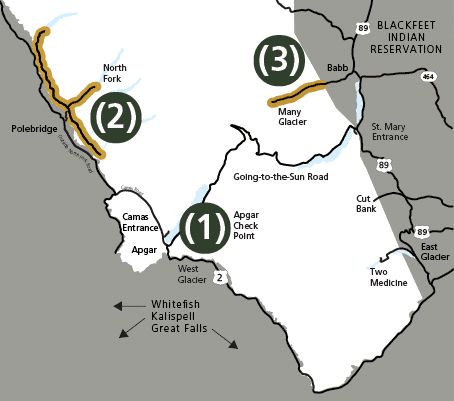
Reservations can be obtained online via recreation.gov starting on January 25, 2024 and are available on a rolling basis 120 days in advance.
These reservations will sell out within minutes. For more information and tips on getting a Glacier National Park reservation, read this ultimate guide on the 2024 Glacier National Park reservation system.
Best Time for Hiking Glacier National Park
The best time to hike in Glacier National Park is from July to mid-September.
During these months, all park areas are open, including Going-to-the-Sun Road. In addition, trails are open and snow-free, making for a more enjoyable experience.
But remember, because the park has such a narrow tourism peak season, the park will be crowded. The best way to beat the crowds at Glacier is to start your day early, arriving at trailheads before 8 AM.
In addition, visiting in early September after Labor Day provides a break from United States summer crowds while the weather is still warm.
Read More: The Best Time to Visit Glacier National Park
Best Hikes in West Glacier & Lake McDonald in Glacier National Park
West Glacier is the closest part of the park to Kalispell, the most common airport for visitors to Glacier National Park.
These hikes are best suited for days spent in the western part of the park.
1. Avalanche Lake Trail
- Distance: 4.6 miles
- Elevation Gain: 500 feet
- Difficulty: Moderate
- Time to Hike: 3 hours
- Trailhead: Avalanche Picnic Area
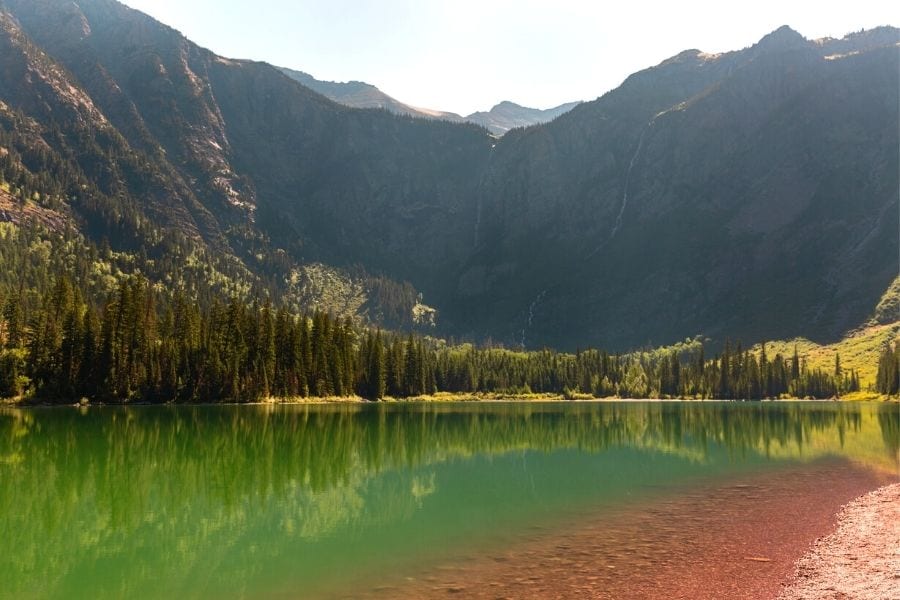
Avalanche Lake is one of the most popular hikes on the west side of Glacier National Park. However, unlike many other hikes in Glacier, the Avalanche Lake Trail is filled with dense forest and lush greenery reminiscent of the Pacific Northwest.
The trail initially shares the same path as the Trail of the Cedars, navigating through an old-growth cedar and hemlock forest.
When you reach Avalanche Gorge, you’ll turn off onto the Avalanche Lake Trail, following rolling hills along the bright teal Avalanche Creek.
Upon reaching the lake, you’ll have impressive views of the avalanche chutes and beautiful waterfalls that feed the lake’s healthy supply of driftwood. Then, venture to the far end of the lake to escape the crowds, the perfect spot for a picnic.
2. Trail of the Cedars
- Distance: 1.4 miles
- Elevation Gain: None
- Difficulty: Easy
- Time to Hike: 30 minutes
- Trailhead: Avalanche Picnic Area
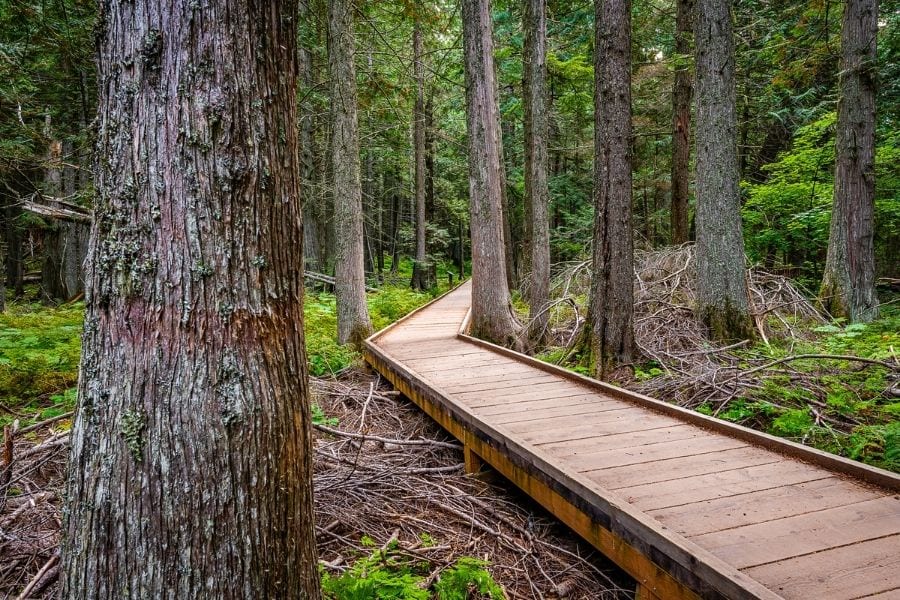
Trail of the Cedars is one of the few handicap-accessible trails in the park. Starting across the street from the Avalanche Creek Picnic Area, an elevated boardwalk path easily accessible by wheelchairs and strollers guides you through an old-growth forest.
The forest is home to cedars and hemlocks not found in other parts of the park. Along the trail, you’ll find educational signs explaining the geology and history of the nature of Glacier’s old-growth forests.
3. Sperry Chalet Trail
- Distance: 12.6 miles
- Elevation Gain: 3,432 feet
- Difficulty: Strenuous
- Time to Hike: 8-10 hours
- Trailhead: Sperry Trailhead
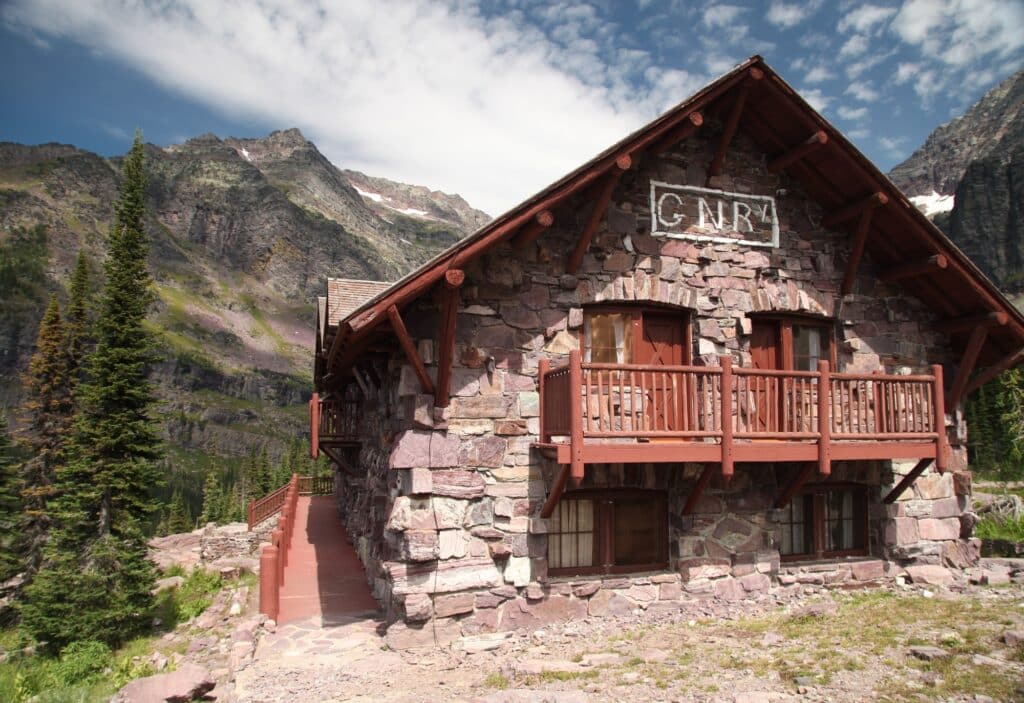
Spending the night at the Sperry Chalet is one of the most exclusive experiences in Glacier National Park. This rustic lodge, part of the National Register of Historic Places, is located more than 6 miles into the wilderness off Going-to-the-Sun Road.
If you can get one of the coveted overnight reservations, you’ll be treated to warm meals and a cozy bed inside a private room at the Sperry Chalet.
After closing due to fire damage from a 2017 wildfire, the Sperry Chalet was renovated and reopened in 2021.
For an extra challenge, continue past Sperry Chalet on a day hike to see the Sperry Glacier, an impressive sight only seen by those who venture into the backcountry.
4. Johns Lake Loop
- Distance: 6 miles
- Elevation Gain: 160 feet
- Difficulty: Easy
- Time to Hike: 1 hour
- Trailhead: Johns Lake Trailhead
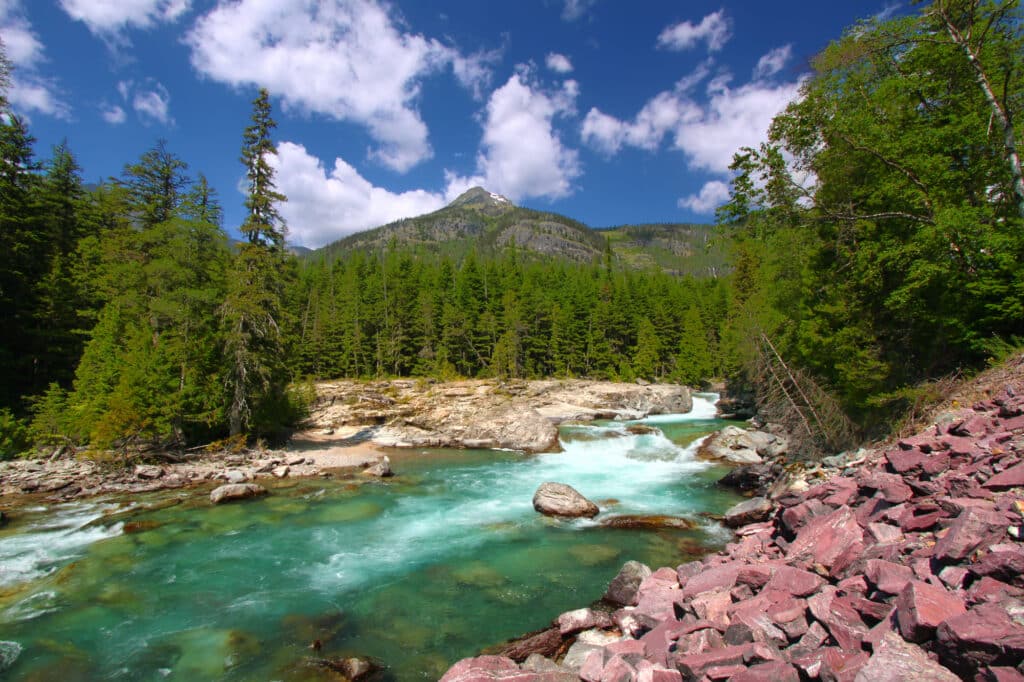
The Johns Lake Loop is an excellent option for an easy hike. The 6-mile trail has minimal elevation gain and includes two waterfalls along Lake McDonald Creek: McDonald Falls and Sacred Dancing Cascade.
The trail starts at the Johns Lake Trailhead but can also be hiked from the viewpoints of McDonald Falls or Sacred Dancing Cascades.
You’ll navigate through an old-growth forest filled with cedar and hemlock trees, coming upon Johns Lake, marshy grasses, and water lilies. If you’re lucky, you may even spot a moose!
After passing the lake, you’ll complete the loop with stops at Sacred Dancing Cascade and McDonald Falls.
Don’t miss the best sights in Glacier on your upcoming trip! This free, printable guide to Going-to-the-Sun Road covers all the best points of interest, tips for avoiding crowds along Glacier’s best scenic drive, and an exclusive map!
Download your free Going-to-the-Sun Road guide here.
Best Hikes in Logan Pass & St. Mary in Glacier National Park
Compared to the western part of the park, Logan Pass and St. Mary feature more alpine landscapes, mountain views, and opportunities to see wildlife like marmots, mountain goats, bighorn sheep, and bears.
5. Highline Trail
- Distance: 11.8 miles
- Elevation Gain: 800 feet
- Difficulty: Strenuous
- Time to Hike: 6 to 8 hours
- Trailhead: Logan Pass Visitor Center
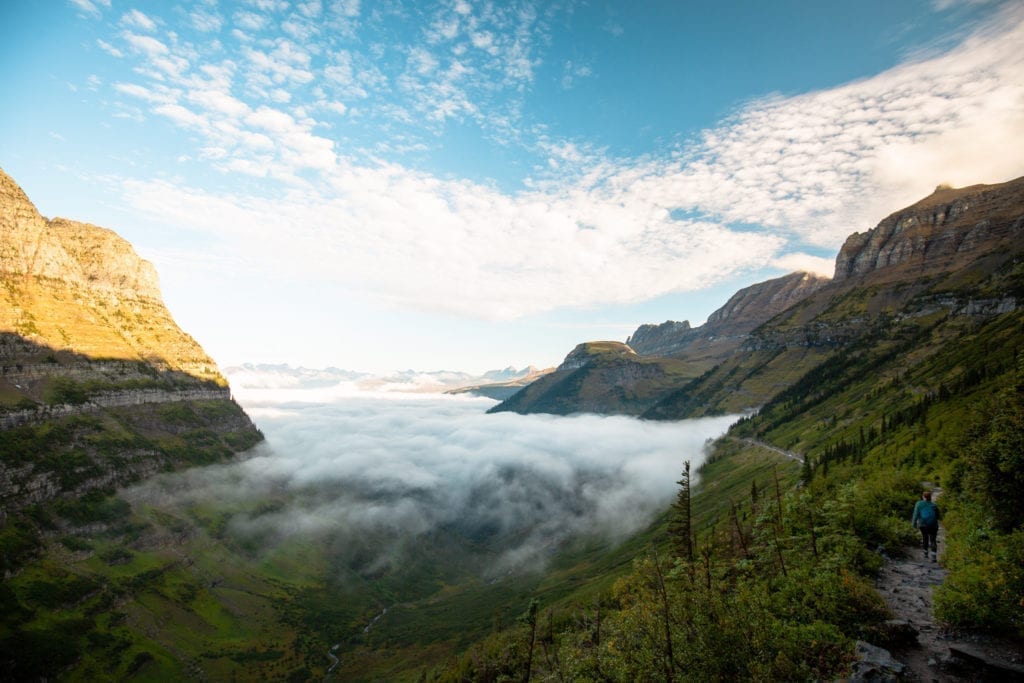
The Highline Trail starts at the highest point along Going-to-the-Sun Road, Logan Pass Visitor Center. This incredibly popular hike offers a sample of all Glacier National Park has: breathtaking vantage points, plenty of wildlife, and diverse landscapes, from meadows to rocky ridgelines.
Traditionally the Highline Trail is hiked one-way, starting at Logan Pass Visitor Center and ending at The Loop, returning on the free Glacier National Park shuttle.
However, if you only want to hike a portion of the trail, you can hike from Logan Pass to Haystack Pass before returning on the same path.
The trail starts with a steep climb above Going-to-the-Sun Road, featuring cables bolted into the towering rock wall for safety. As you continue, the path widens to an open terrain of wildflower-filled meadows with the best views of Lake McDonald Valley.
Keep your eyes peeled for marmots and mountain goats!
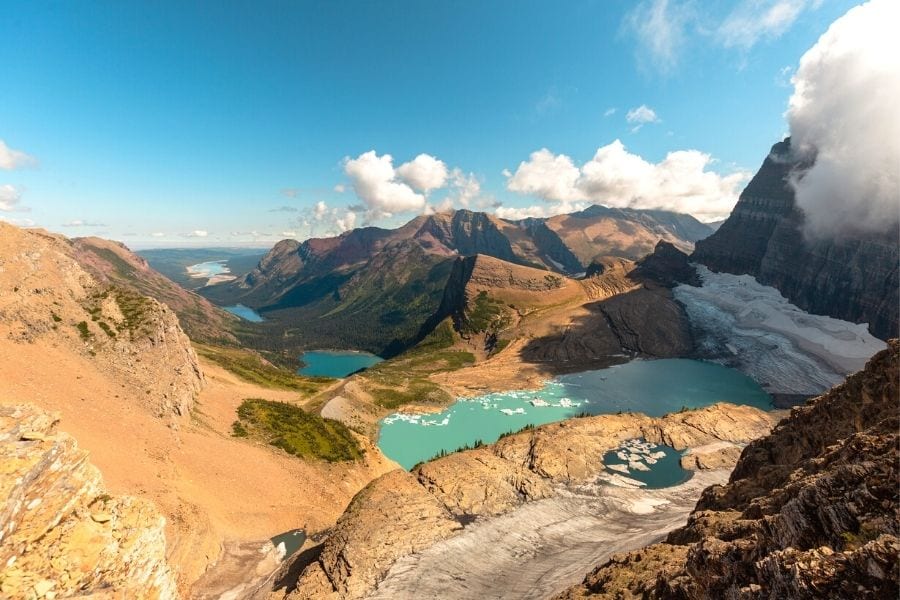
About halfway through, you’ll reach a spur trail: the Grinnell Glacier Overlook along The Garden Wall. This incredibly steep trail adds about 2 miles roundtrip, taking you atop the mountain to stand on the Continental Divide.
This viewpoint atop the Continental Divide provides amazing views of Grinnell Glacier, the McDonald Valley, Many Glacier Valley, and more than five lakes!
The Highline Trail wraps up with a stop at the Granite Park Chalet, a backcountry lodge, and descends through the wildfire-scorched section of forest down to The Loop.
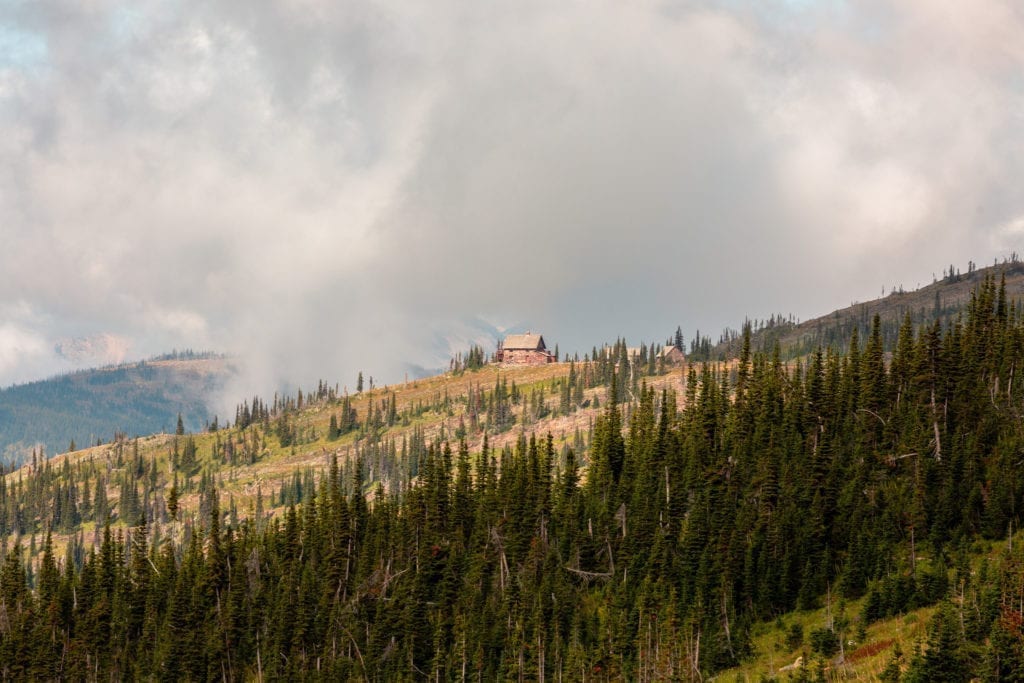
The most scenic part of the hike is the portion from Logan Pass to The Garden Wall. While the trail is long, the elevation is less intense, making this a fantastic hike doable by anyone used to walking long distances.
As one of the most popular trailheads, parking at Logan Pass Visitor Center fills up early. Plan to arrive by 8 AM to secure a parking spot.
Read More: Ultimate Guide to the Highline Trail
6. Hidden Lake Overlook Trail
- Distance: 2.8 miles
- Elevation Gain: 460 feet
- Difficulty: Moderate
- Time to Hike: 1.5 to 2 hours
- Trailhead: Logan Pass Visitor Center
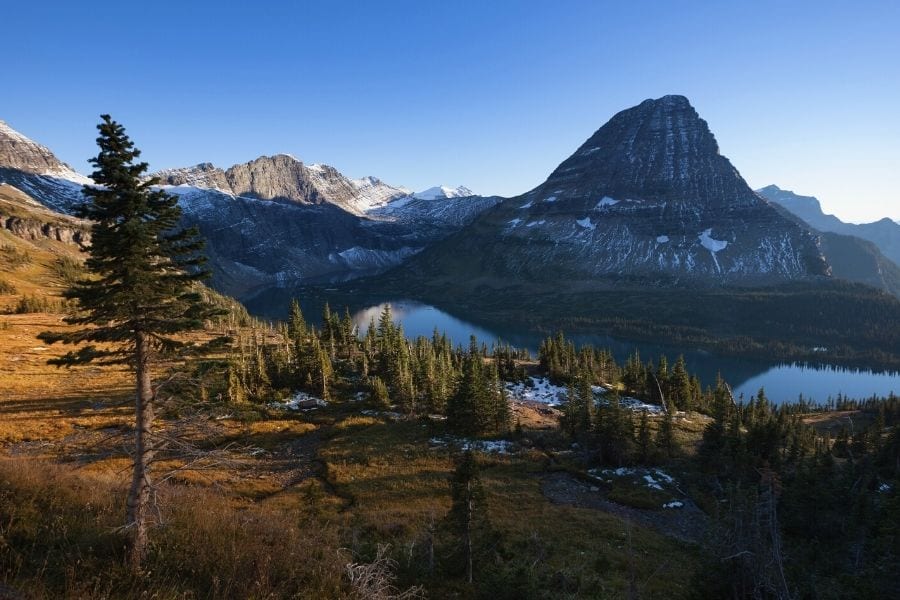
The Hidden Lake Overlook Trail is another popular route starting from the Logan Pass Visitor Center in the park’s heart. This picturesque trail provides plenty of opportunities to see wildlife, like mountain goats and bighorn sheep.
The trail starts on a paved path behind the visitor center. As you continue along the trail, you’ll traverse both boardwalk and gravel paths through the Hanging Gardens. This area provides excellent views of Clements Mountain, an arrow-shaped peak towering above the trail.
The open meadows along the route are known for mountain goat sightings and plentiful wildflowers. After around 1.5 miles, you’ll reach the overlook providing beautiful views of Hidden Lake. This is an excellent spot for sunrise or sunset, providing a break from crowds.
For an additional challenge, you can continue down to the shore of the lake, adding about 2.5 miles roundtrip. However, this route can sometimes be closed due to bear activity in late summer.
Again, parking at Logan Pass Visitor Center fills up early. Plan to secure a parking spot by 8 AM or after 4 PM.
7. St. Mary and Virginia Falls Trail
- Distance: 3.6 miles
- Elevation Gain: 285 feet
- Difficulty: Moderate
- Time to Hike: 1.5 to 2 hours
- Trailhead: St. Mary Falls Trailhead
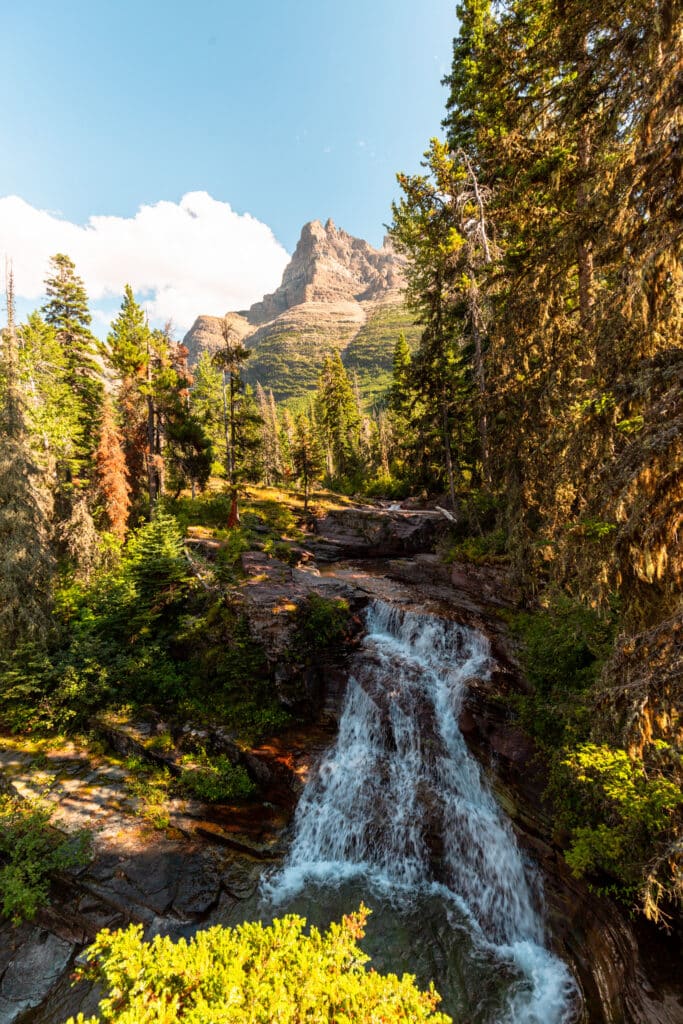
If you’re more interested in waterfalls than mountain views, don’t miss St. Mary and Virginia Falls Trail! This moderate trail covers two famous waterfalls in Glacier National Park: St. Mary Falls and Virginia Falls.
The trail starts at the St. Mary Falls Trailhead off Going-to-the-Sun Road, a popular Glacier National Park shuttle stop. However, you can also reach the falls starting from Sunrift Gorge or Sun Point instead. Sun Point provides the most parking and is your best option if you are visiting at midday.
After a quick descent through the fire-scarred forest towards St. Mary Lake, you’ll arrive at St. Mary Falls. This two-tiered waterfall gushes bright, icy blue water fueled by glacial melt. In the heat of summer, you can jump into the falls and nearby creek for a quick swim!
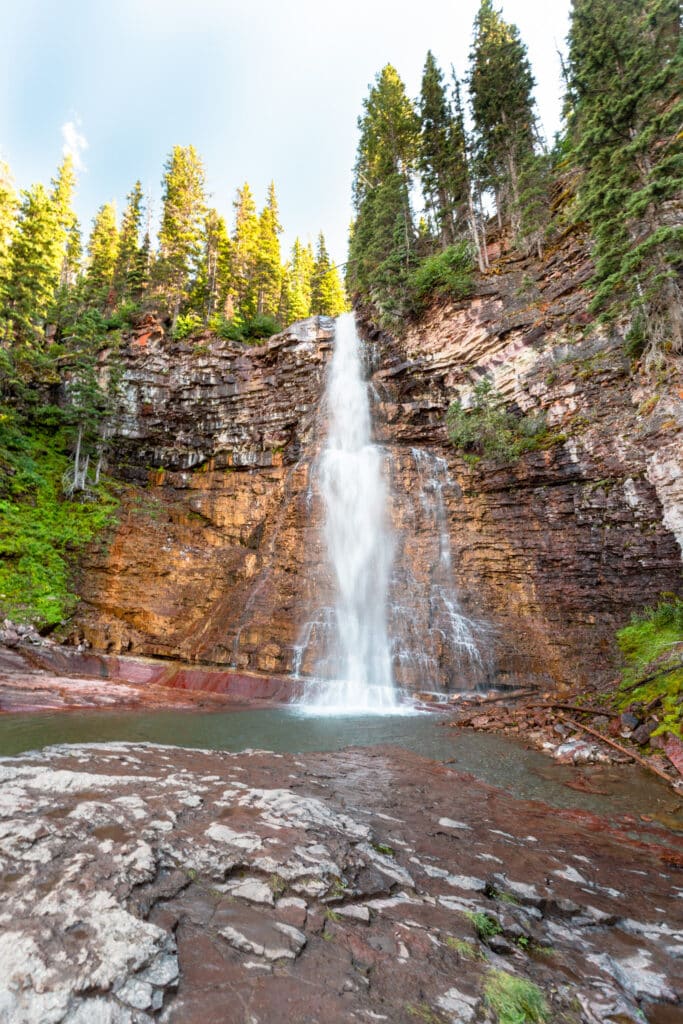
Continuing about a mile past St. Mary Falls, you’ll reach Virginia Falls. This taller, single cascade drops over 50 feet, putting off a powerful mist of icy glacial water. Virginia Falls is arguably the more impressive of the two falls and gets fewer visitors than St. Mary Falls.
8. Siyeh Pass Trail
- Distance: 9.2 miles
- Elevation Gain: 2,240 feet
- Difficulty: Strenuous
- Time to Hike: 6 to 8 hours
- Trailhead: Piegan Pass Trailhead

The Siyeh Pass Trail is a challenging but rewarding trail through the heart of the Logan Pass region, providing excellent mountain and alpine meadow views. Like the Highline Trail, Siyeh Pass is a one-way route.
The trail starts at the Piegan Pass Trailhead and ends at Sunrift Gorge, further down Going-to-the-Sun Road.
The scenic route takes you on one of the highest maintained trails in the park to the saddle of Mount Siyeh, providing panoramic views of the Logan Pass and St. Mary regions.
You’ll also see Sexton Glacier on this less crowded trail that is an excellent alternative to the Highline Trail.
While you could hike this trail in reverse, starting at Piegan Pass minimizes the amount of elevation gain. The easiest way to handle transportation is to park at either the trail start or end and utilize the Glacier National Park free shuttle.
You could also return the same way you came for an out-and-back hike.
9. Piegan Pass Trail
- Distance: 9.0 miles
- Elevation Gain: 1,750 feet
- Difficulty: Strenuous
- Time to Hike: 6 to 8 hours
- Trailhead: Piegan Pass Trailhead
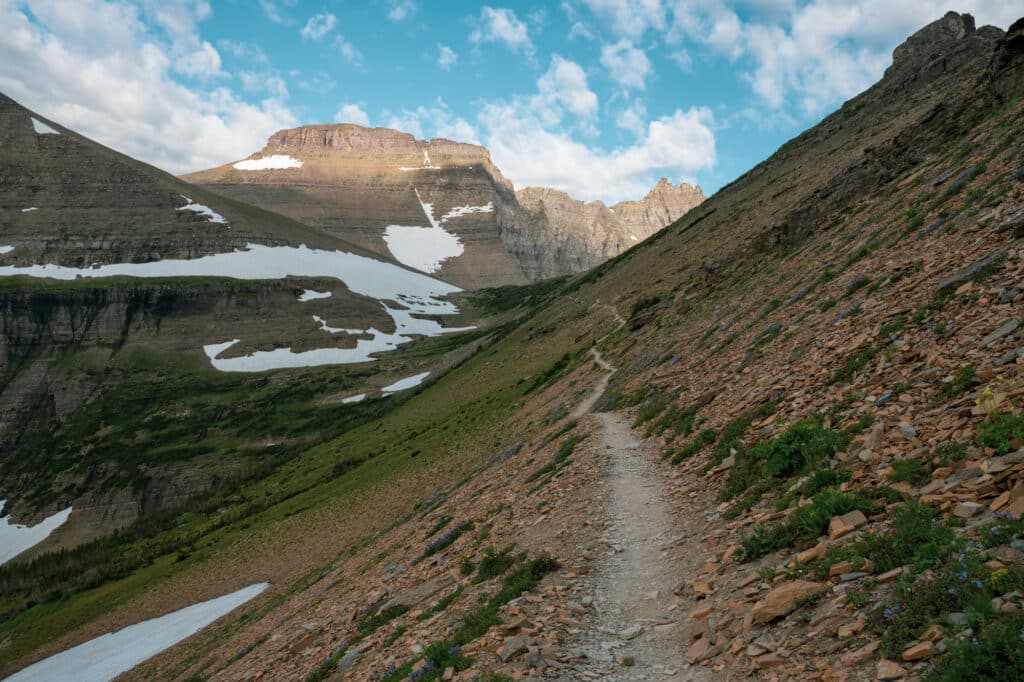
If you seek more solitude, opt for the Piegan Pass Trail instead. This strenuous route provides views of the Logan Pass region and three glaciers: Jackson Glacier, Blackfoot Glacier, and Piegan Glacier.
You’ll begin at the Piegan Pass Trailhead, the same starting point as the Siyeh Pass Trail, and follow the same trail for the first 2.6 miles. You’ll then reach a trail junction, taking the left turn to hike towards Piegan Pass, eventually reaching the saddle of Piegan Mountain and Mount Pollock.
The hike is scenic, passing through Preston Park, a stunning alpine meadow filled with colorful wildflowers in the summer.
10. Baring Falls Trail
- Distance: 0.6 miles
- Elevation Gain: 250 feet
- Difficulty: Easy
- Time to Hike: 30 minutes
- Trailhead: Sunrift Gorge Pullout

If you’re looking for an easy hike in the St. Mary area, don’t miss the Baring Falls trail. This easy hike takes you to a glacial waterfall, Baring Falls, often overshadowed by the nearby St. Mary Falls and Virginia Falls.
However, this is one of the most easily accessible waterfalls in the park, located only a quarter mile from the Sunrift Gorge pullout. You can also reach Baring Falls from Sun Point on a slightly longer but easy hike.
11. Gunsight Lake Trail
- Distance: 13.2 miles
- Elevation Gain: 1,750 feet
- Difficulty: Strenuous
- Time to Hike: 6 to 8 hours
- Trailhead: Gunsight Pass Trailhead / Jackson Glacier Overlook
One of the longer hikes on this list, the Gunsight Lake Trail is perfect for those looking for a challenging hike with plenty of solitude. The trail starts along Going-to-the-Sun Road just past Siyeh Bend at the Jackson Glacier Overlook.
You’ll initially descend from Jackson Glacier Overlook, opening up into an alpine valley along the St. Mary River and Reynolds Creek. Gunsight Lake is a classic glacial lake filled with bright teal water surrounded by mountains. If you have a backcountry camping permit, you can spend the night along the lakeshore.
This trail is known for grizzly bear, black bear, and moose sightings!
Best Glacier National Park Hikes in Many Glacier
Many Glacier is one of the best hiking regions in Glacier National Park. You’ll find classic trails like Grinnell Glacier and Iceberg Lake here.
If you are coming to Glacier National Park to hike, this is an excellent place to explore.
12. Grinnell Glacier Trail
- Distance: 10.6 miles (only 7.2 miles with boat tour)
- Elevation Gain: 1,600 feet
- Difficulty: Strenuous
- Time to Hike: 6 to 8 hours
- Trailhead: Many Glacier Hotel near the Many Glacier Ranger Station

The Grinnell Glacier Trail is one of the top hikes in Glacier National Park. The challenging trail takes you past four glacial lakes and provides views of several glaciers, including its namesake Grinnell Glacier.
There are two ways to hike this trail:
- Hiking from the trailhead along Swiftcurrent Lake and Lake Josephine, totaling 10.6 miles
- Taking the boat tour as a split roundtrip from the Many Glacier Hotel that drops you off at the far end of Lake Josephine, saving 3.4 miles roundtrip
While you may not save time or avoid elevation gain by taking the boat ride, you get the unique experience of learning from knowledgeable boat tour guides.
After Lake Josephine, the trail begins climbing, transitioning from a forested trail to a more exposed alpine landscape. As you ascend, you’ll get a view from above of the wildflower-filled alpine meadows and teal water of Lower Grinnell Lake.
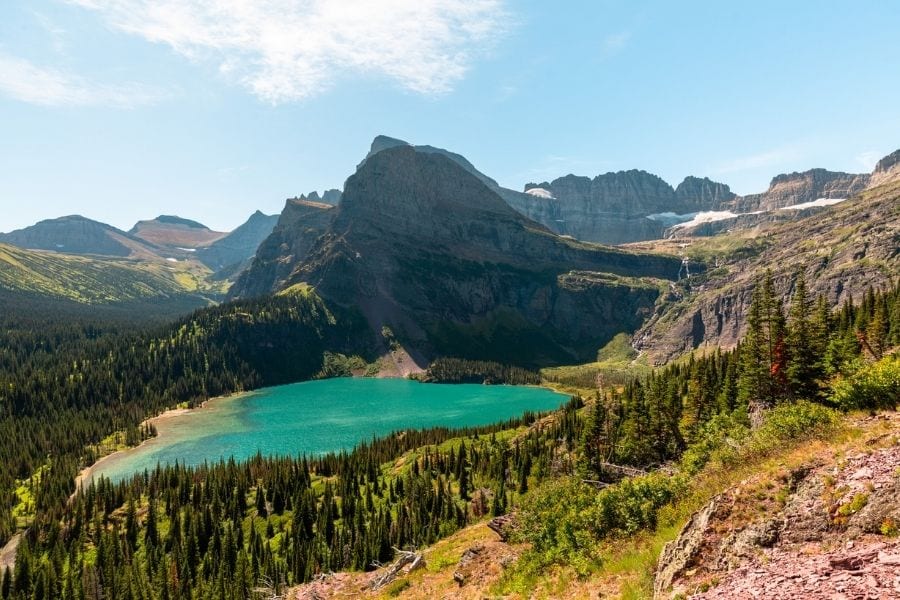
The final vantage point at Upper Grinnell Lake is the most stunning. The trail dead ends at a bright, icy turquoise-blue lake, with icebergs and all.
The lake is surrounded by glaciers, including Grinnell Glacier and Salamander Glacier, and the towering mountains of The Garden Wall, which can be reached from the Highline Trail.
This hike is a must-do and provides plenty of opportunities to see grizzly bears, mountain goats, bighorn sheep, and moose.
13. Iceberg Lake Trail
- Distance: 9.6 miles
- Elevation Gain: 1,200 feet
- Difficulty: 4 to 6 hours
- Time to Hike: Moderate
- Trailhead: Iceberg Ptarmigan Trailhead
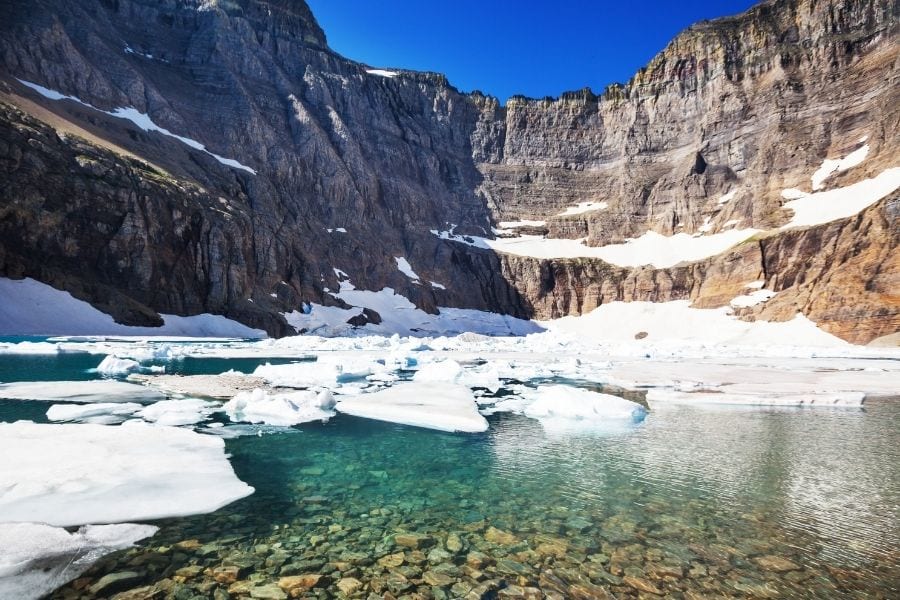
Iceberg Lake is another quintessential Many Glacier hiking trail. The moderate hike starts behind the Swiftcurrent Motor Inn, climbing up to an icy glacial lake filled with icebergs. The water is so cold that icebergs remain all year long!
The first several miles of the trail are shared with the route to Ptarmigan Tunnel. They are known for grizzly bear sightings amongst the huckleberry bushes. After reaching Ptarmigan Falls, you’ll split off, staying left towards Iceberg Lake.
Upon reaching Iceberg Lake, you’ll be greeted with bright blue water surrounded by towering snowy mountains. This is the perfect spot for a picnic lunch before returning the way you came.
14. Ptarmigan Tunnel Trail
- Distance: 10.6 miles
- Elevation Gain: 2,300 miles
- Difficulty: Strenuous
- Time to Hike: 6 to 8 hours
- Trailhead: Iceberg Ptarmigan Trailhead
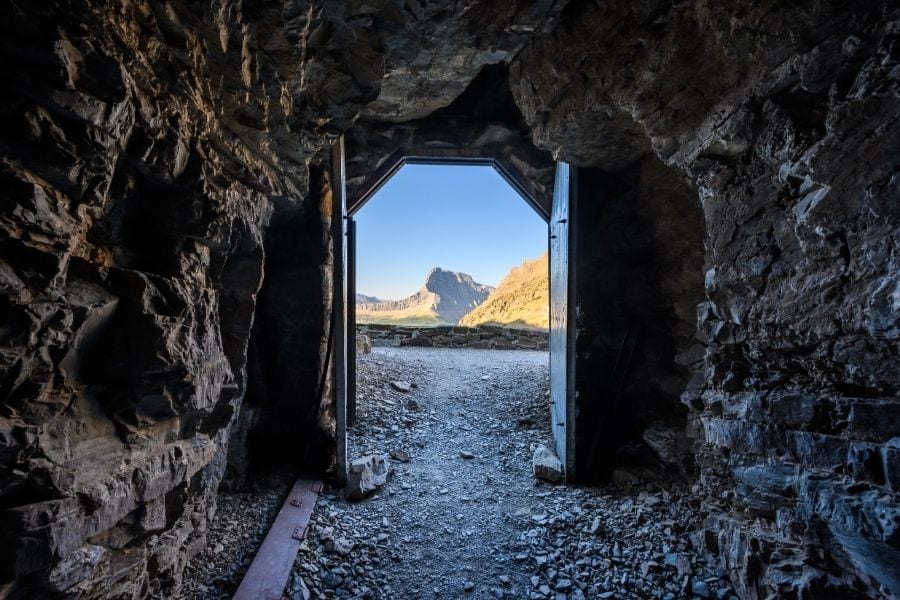
One of the more unique trails in Glacier National Park, the Ptarmigan Tunnel trail takes you on a strenuous journey to a nearly century-old tunnel carved into the mountainside.
Initially built in 1930 by the Civilian Conservation Corps for horses and tours, this 250-foot tunnel connects the Many Glacier Valley and Belly River Valley, drilled through the towering Ptarmigan Wall.
Due to heavy snowfall, the tunnel is only open from late July to September. So if you’re visiting in late June or early July, save this trail for later in the season – it’s not worth it if you can’t pass through the tunnel!
The first 2.7 miles of this trail are shared with the Iceberg Lake trail. When the path splits at Ptarmigan Falls, you’ll continue towards Ptarmigan Lake. As you approach the tunnel, you’ll catch sight of the steep switchbacks leading up to the tunnel, covering 500 feet in less than a mile.
Once conquered, you can pass through Ptarmigan Tunnel, greeted with impressive views of a new part of the park on the other side.
Optional Iceberg Lake and Ptarmigan Tunnel Loop
If you’re interested in a longer hike, combine the hikes to Iceberg Lake and Ptarmigan Tunnel. First, make the 2.7-mile trek to Ptarmigan Falls, then hike out to Iceberg Lake before making the trek up to Ptarmigan Tunnel. This combined hike is roughly 14.8 miles and 2,800 feet in elevation.
15. Cracker Lake Trail
- Distance: 12.8 miles
- Elevation Gain: 1,400 feet
- Difficulty: Moderate
- Time to Hike: 5 to 7 hours
- Trailhead: South end of Many Glacier Hotel parking lot
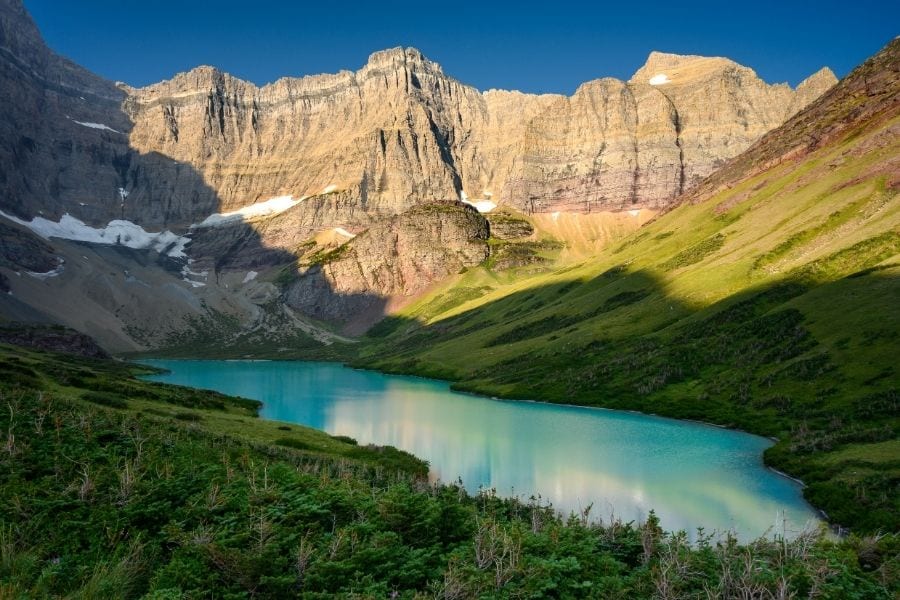
There’s no shortage of bright blue alpine lakes in the Many Glacier. If you’ve already hiked Grinnell Glacier and Iceberg Lake, Cracker Lake is another excellent trail!
The trail starts at the Many Glacier Hotel parking lot, passing by Sherburne Lake on the gradual ascent. You’ll hike through long stretches of the forest before reaching Cracker Lake. The alpine lake is surrounded by wildflower-filled meadows and framed by mountain peaks.
Like other trails in the area, this hike is known for bear sightings, so be sure to bring your bear spray!
16. Swiftcurrent Pass
- Distance: 13.6 miles
- Elevation Gain: 2,300 feet
- Difficulty: Strenuous
- Time to Hike: 8 to 10 hours
- Trailhead: Swiftcurrent Trailhead by Swiftcurrent Motor Inn parking area
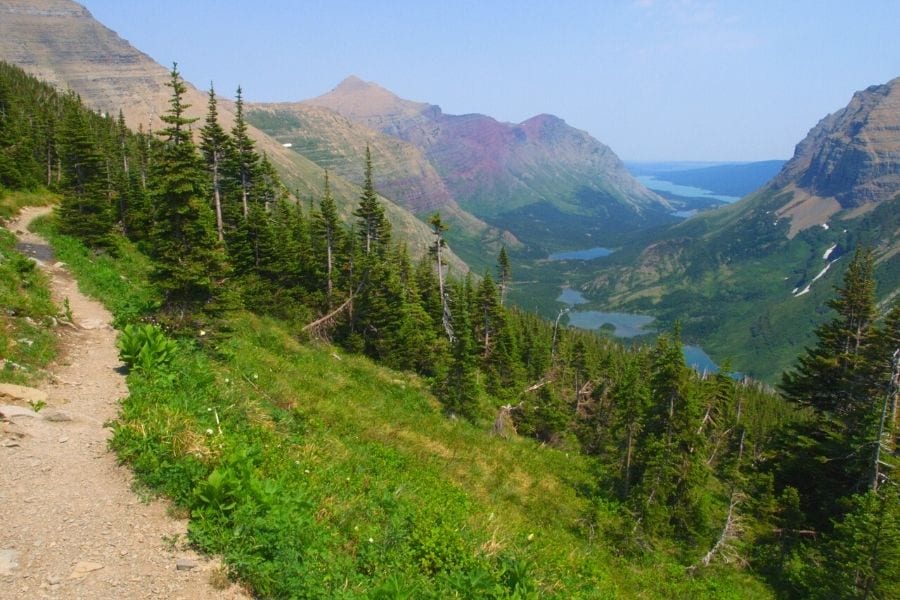
For avid backcountry enthusiasts, the Swiftcurrent Pass is a must-do! The trail takes you past a series of lakes to the Swiftcurrent Valley atop the Continental Divide. Plus, with a short side trip, you can visit the impressive Swiftcurrent Fire Lookout along the highest-maintained trail in the park.
The trail starts at the Swiftcurrent Trailhead by the Swiftcurrent Motor Inn. The initial part of the trail is relatively flat, passing by Fishercap Lake, Redrock Lake, Redrock Falls, and Bullhead Lake, all popular places to spot moose.
Once you reach the Swiftcurrent Valley, you’ll have views of several more lakes, Heavens Peak, and Granite Peak in the distance.
Since this trail covers high elevation, some parts can be snow-covered until July or August.
17. Redrock Falls Trail
- Distance: 3.6 miles
- Elevation Gain: 100 feet
- Difficulty: Easy
- Time to Hike: 1 to 2 hours
- Trailhead: Swiftcurrent Trailhead by Swiftcurrent Motor Inn parking area
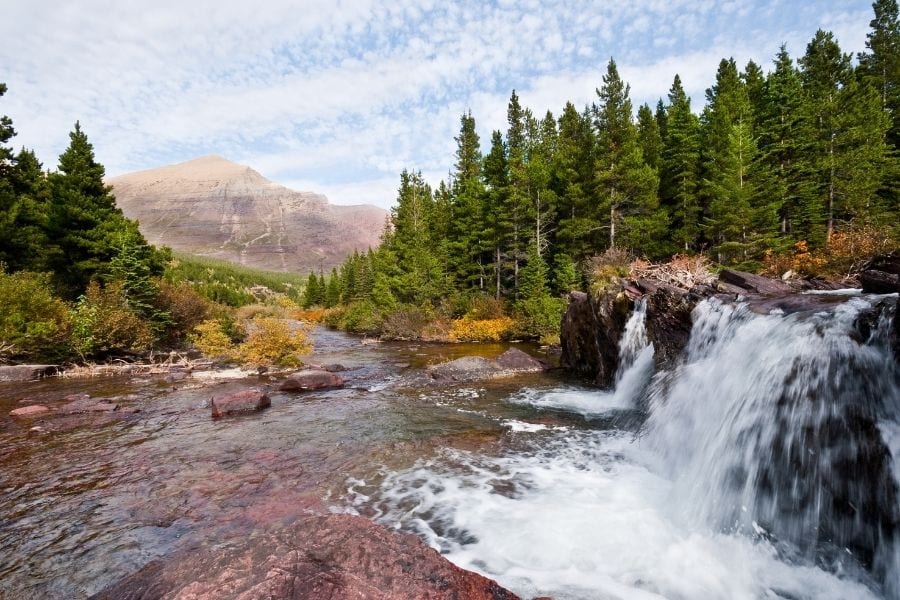
One of the easier trails in the Many Glacier area, the Redrock Falls trail is known as one of the best places in the park to see moose.
The trail starts at the Swiftcurrent Trailhead, just past the Swiftcurrent Motor Inn. The mostly flat path passes Fishercap Lake and Redrock Lake on the way to the falls. Be sure to detour to the lakeshores to check for moose feeding.
You’ll reach the end of the trail at Redrock Falls, a misty cascade at the base of Swiftcurrent Mountain.
18. Grinnell Lake Trail
- Distance: 6.8 miles (only 2.2 miles with boat tour)
- Elevation Gain: 60 feet
- Difficulty: Easy
- Time to Hike: 2 to 3 hours
- Trailhead: Many Glacier Hotel near the Many Glacier Ranger Station

If you’re looking for a less strenuous alternative to the Grinnell Glacier trail, you can opt to hike to Grinnell Lake instead. This hike provides the same beautiful meadow and mountain views but with limited elevation gain.
Instead of climbing to Upper Grinnell Lake, you’ll stop at Lower Grinnell Lake.
Like the Grinnell Glacier Trail, you can hike from the Many Glacier Hotel along Swiftcurrent Lake and Lake Josephine, totaling 6.8 miles. Alternatively, you can take the boat tour from Many Glacier Hotel, saving about 4.6 miles.
With the boat tour, this is an easy 2.2-mile trail that is perfect for families or those looking for a low-impact trail. Glacier Park Boat Company also offers a guided hike and boat tour option.
Best Glacier National Park Hikes in Two Medicine
Two Medicine is less crowded than other parts of the park due to its location. You’ll need to drive about an hour south of St. Mary to get here. But you’re rewarded with more solitude and some of Glacier’s best sunrise views.
19. Pitamakan Pass & Dawson Pass Loop
- Distance: 17.5 feet
- Elevation Gain: 2,700 feet
- Difficulty: Strenuous
- Time to Hike: 10 to 12 hours
- Trailhead: North Shore Trailhead
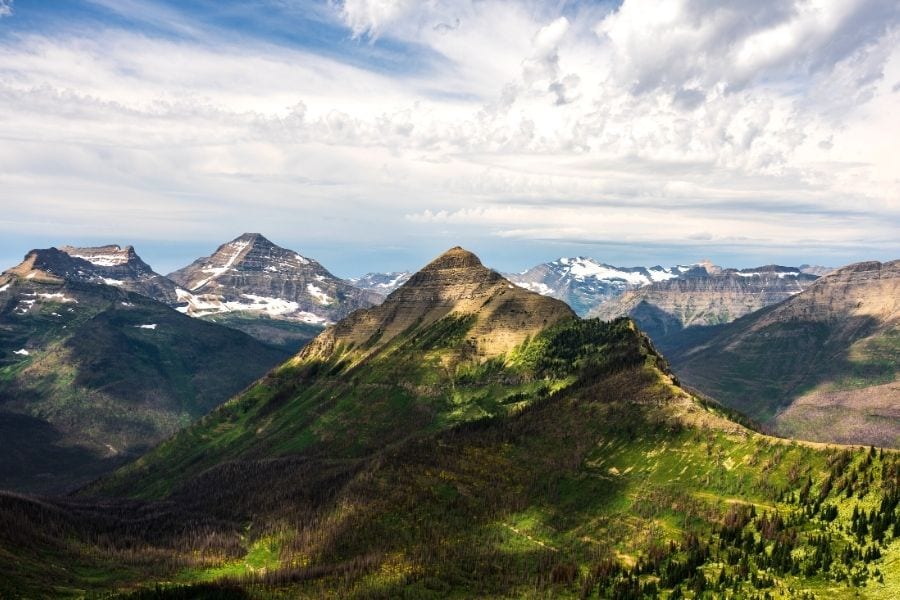
The longest trail on this list, the Pitamakan-Dawson Loop, is not for the faint of heart. It’s incredibly remote and filled with solitude and epic views. However, this should only be attempted as a day hike by those in great shape.
Starting at the North Shore Trailhead along Two Medicine Lake, you can hike this trail either clockwise or counterclockwise. The Dawson Pass ascent is steeper than the Pitamakan Pass ascent. If you want a less steep route, start with the Pitamakan Pass, going counterclockwise.
The stunning route covers alpine lakes, meadows, avalanche chutes, and mountain peaks. From Pitamakan Pass, you have a panoramic view of five alpine lakes.
The section between Dawson Pass and Pitamakan Pass is one of the most scenic stretches of trail in Glacier National Park.
With a backcountry permit, you could turn this hike into a multi-day trip, staying at Oldman Lake and No Name Lake. The hike can also be shortened by taking the Two Medicine boat tour to the far end of Two Medicine Lake before hiking Dawson Pass, saving 3 miles.
Parts of the trail at higher elevations can be snowcovered and require crampons even in summer months. For the best conditions, hike this trail in August or September.
20. Paradise Point Trail
- Distance: 1.4 miles
- Elevation Gain: 100 feet
- Difficulty: Easy
- Time to Hike: 30 minutes
- Trailhead: South Shore Trailhead
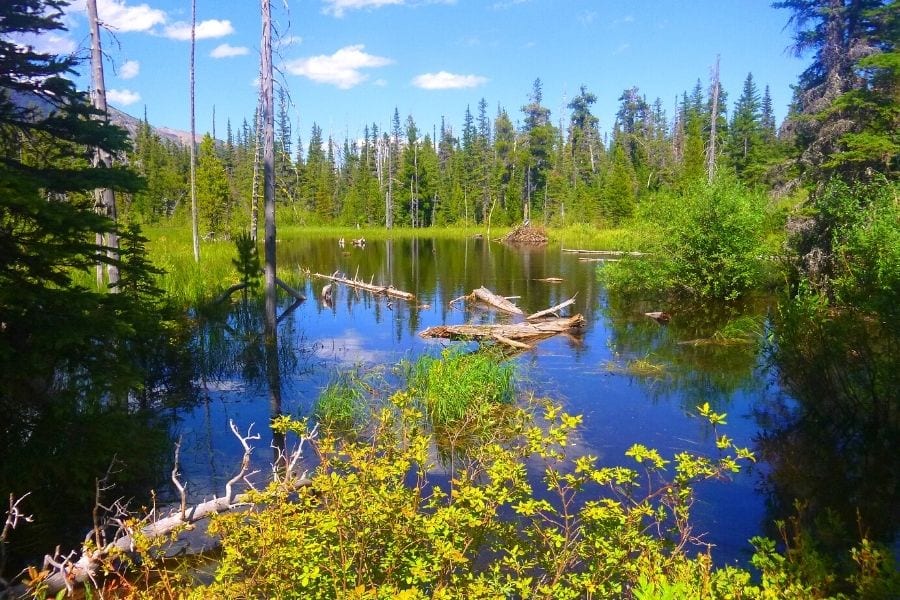
Two Medicine is known for more strenuous trails, like the Pitamakan-Dawson Loop above. But Paradise Point provides an excellent opportunity to explore Two Medicine without as much exertion.
The trail starts at the Two Medicine Lake parking lot and takes you around the side of the lake. You may even spot some beavers! This hike is beautiful at sunrise when the surrounding mountains are reflected in the still lake.
Essential Information for the Best Day Hikes in Glacier National Park
- Glacier National Park requires visitors to purchase a pass to enter the park. If you plan to visit more than one national park in a year, the America the Beautiful pass is an excellent investment. For only $80, you get unlimited access to 400+ national park sites for 12 months.
- Glacier National Park will require separate vehicle reservations in 2024. All visitors need a reservation to enter Going-to-the-Sun Road, North Fork, Many Glacier, and Two Medicine. Read more about the Glacier National Park reservation system.
- Arrive at the trailhead early. For trails starting at Logan Pass or Many Glacier, plan to begin your hike by 8 AM to guarantee you find a parking spot and avoid crowds.
- Most trails can only be hiked from July to September. Going-to-the-Sun Road around Logan Pass is closed from Fall through early Summer, and many trails are closed due to snowfall. Read more about historical Going-to-the-Sun Road opening and closing dates.
- Always check trail status before hiking in Glacier National Park. For the latest updates, including closures due to construction, weather, or bear activity, refer to the Glacier National Park website. Speaking with park rangers is also an excellent way to check in on trail status.
- Keep your distance from wildlife. While animals are fun to photograph and look at (don’t forget your binoculars!), keep your distance. You should stay 100 yards away from bears and wolves and 25 yards away from all other wildlife.
- Carry bear spray on every hike. Bear spray is required by the National Park Service for all hikers, even on a short walk, as Glacier is in grizzly bear country. You can buy bear spray in advance or rent it when you arrive. Bear spray is available at most local outdoor stores.
- Dress in layers. Temperatures at higher elevations on trails or at Logan Pass can differ dramatically from lower elevations, like St. Mary or Lake McDonald. So pack warm fleece layers and a rain jacket for the occasional summer shower.
Looking for more tips on what to pack for your trip? Check out my guides on the best hiking gear, what to pack for a road trip, and essential camping gear for all my favorite gear picks and tips to make packing for your trip a breeze!
Where to Stay Near the Best Trails in Glacier National Park
This interactive map can help you search all the available hotels and rental properties near Glacier National Park! Simply scroll and click the map below to see what is available!
These are the best places to stay near the Glacier National Park hiking trails:
West Glacier
- Lake McDonald Lodge – Swiss-style lodge with fantastic lake views and a handful of restaurants
- Village Inn at Apgar – Motel-like inn with both standard and full-kitchen rooms
- Belton Chalet – 3-star hotel along the Flathead River walkable to shops in West Glacier
- Glacier Guides Lodge – Lodge within walking distance of the shops in West Glacier
- Glacier Outdoor Center – Mountain lodge offering private cabins only five minutes from the West Entrance
- Great Northern Resort – Cabins located along the historic Great Northern Railway, a short drive to West Entrance
Going-to-the-Sun Road & St. Mary
- Rising Sun Motor Inn – Rustic option with a restaurant and a gift shop near St. Mary Lake
- St. Mary Village – 3-star resort only a short walk from the St. Mary Entrance
- Cottages at Glacier – Cozy 2-bedroom cabins just outside the park in St. Mary
Many Glacier
- Many Glacier Hotel – Swiss-style lodge with stunning views and the delicious Ptarmigan Dining Room
- Swiftcurrent Motor Inn – Rustic option with a camp store and close trailhead access
Read More: 35 Best Places to Stay in Glacier National Park
Frequently Asked Questions
What is the number 1 hike in Glacier National Park?
The best hike in Glacier National Park is the Highline Trail. This one-way 12-mile hike samples Glacier’s beauty, from alpine meadows to stunning mountain and valley views. If you only have time for one great hike, don’t miss the Highline Trail on Going-to-the-Sun Road.
What is the hardest hike at Glacier National Park?
The hardest hike in Glacier National Park is the Siyeh Pass Trail. Covering nearly 2,500 feet of elevation in 4.5 miles, the average elevation grade on this trail is roughly 4.5%. The total hike comes in at 9.2 miles, making it one of the park’s most challenging but beautiful all-day hikes.
What side of Glacier National Park is best for hiking?
The east side of Glacier National Park is best for hiking, thanks to the plentiful options and stunning mountain views. You’ll find the best hikes in the Logan Pass and Many Glacier areas. If you’re looking for more family-friendly hikes, consider hiking in West Glacier.
What is the easiest glacier to hike to in Glacier National Park?
The easiest glacier to see in Glacier National Park is Jackson Glacier, which can be seen from an overlook on Going-to-the-Sun Road. However, if you want to hike to a glacier, the best option is the Grinnell Glacier trail in Many Glacier.
What is the best loop hike in Glacier?
The best loop hike in Glacier National Park is the Highline Trail. Although it is a one-way hike starting at Logan Pass Visitor Center and ending at The Loop, you finish by taking the Glacier National Park shuttle back to the visitor center.
Are there easy hiking trails in Glacier National Park?
There are several easy hiking trails in Glacier National Park. The best easy hikes include the Trail of the Cedars and Johns Lake Loop near Lake McDonald, the Baring Falls Trail on St. Mary Lake, the Redrock Falls Trail and Grinnell Lake Trail in Many Glacier, and the Paradise Point Trail in Two Medicine.
Final Thoughts on the Best Glacier National Park Hikes
By far, the easiest way to see the park is on a hike, making it one of the best things to do in Glacier National Park. Plus, Glacier has a hike for all skill levels. This list of the best hikes in Glacier National Park covers all the sights, from easy to strenuous trails.
These are the best hikes in Glacier National Park, ranked:
- Grinnell Glacier Trail
- Highline Trail
- Hidden Lake Overlook Trail
- Iceberg Lake Trail
- Ptarmigan Tunnel Trail
- Cracker Lake Trail
- St. Mary and Virginia Falls Trail
- Avalanche Lake Trail
- Trail of the Cedars
- Swiftcurrent Pass
- Siyeh Pass
- Piegan Pass
- Grinnell Lake Trail
- Redrock Falls Trail
- Sperry Chalet Trail
- Pitamakan Pass & Dawson Pass Loop
- Gunsight Lake Trail
- Johns Lake Loop
- Baring Falls Trail
- Paradise Point Trail
Are you looking for more ideas for your trip to Glacier National Park? Don’t miss these helpful posts!
- Reservations: Glacier National Park 2024 Reservation System
- 3 Day Itinerary: How to Spend 3 Days in Glacier
- 7 Day Itinerary: How to Spend 7 Days in Glacier
- Top Activities: 21 Best Things to Do in Glacier
- Where to Stay: 35 Best Places to Stay in Glacier
- Scenic Drive: Driving Going-to-the-Sun Road in 2024
- Hiking: Hiking the Highline Trail in Glacier
- When to Go: Best Time to Visit Glacier
Don’t miss the best sights in Glacier on your upcoming trip! This free, printable guide to Going-to-the-Sun Road covers all the best points of interest, tips for avoiding crowds along Glacier’s best scenic drive, and an exclusive map!
Download your free Going-to-the-Sun Road guide here.
Don’t Forget to Save This Post on Pinterest
